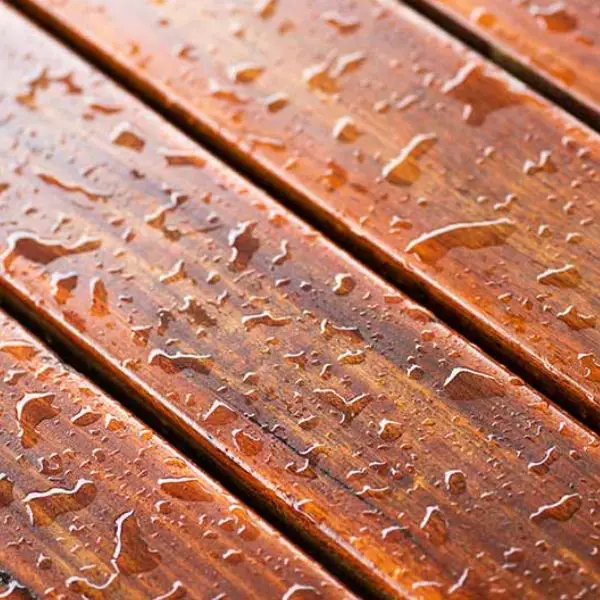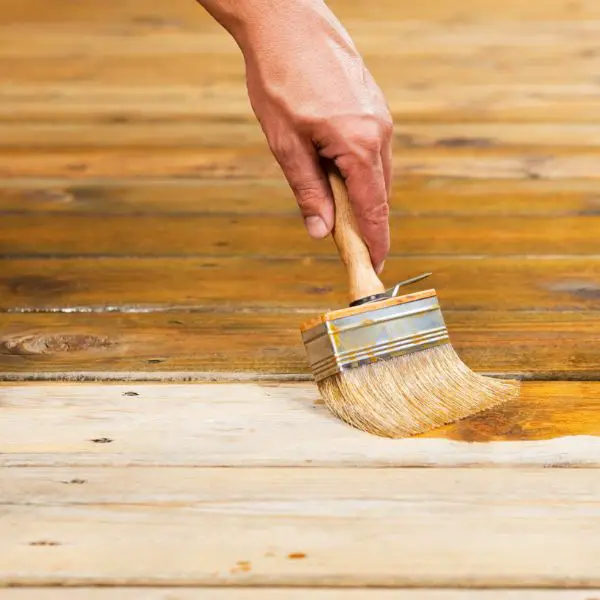When you’re deciding on a stain for your deck, you might wonder whether to go with oil-based or water-based. The choice depends on the type of wood, the weather, how much use the deck will get, and how long you want the stain to last. Both types are good for staining decks, but they have different qualities.
Oil-based stains are great for tough conditions. If your deck sees a lot of foot traffic or faces harsh weather, oil-based stains are a solid choice. They’re also good for wood types that aren’t naturally resistant to rot. Cleaning up after using oil-based stains can be done with mineral spirits.
Water-based stains are ideal for woods like cypress, cedar, and redwood, which are naturally resistant to rot. Cleaning up after using water-based stains is easy too – just soap and water will do the job.
Oil-Based Stains for Decks: What You Need to Know
Oil-based stains have been around for a long time, and these days they’re made to be more eco-friendly. Instead of the old oil-alkyd base, modern oil-based stains might use different kinds of oils like paraffin, synthetic oils, or natural plant oils from Tung, linseed, and soybean.
But remember, some places have rules against using certain stains because of air pollution concerns.
Oil-based stains are really good at protecting wood from moisture, which can prevent rot. They work especially well for woods like spruce, pine, and fir that don’t have their own rot-fighting oils.
For woods that do have natural oils and are more rot-resistant – like redwood, walnut, teak, cypress, and cedar – oil-based stains can still be used, but it’s always a good idea to check the label.
One of the big benefits of oil-based stains is that they soak deep into the wood. This deep penetration helps stop the wood from splitting, cracking, or warping because of moisture. The deeper the stain goes, the better the protection.
Oil stains are often recommended for outdoor wood structures like fences, decks, roofs, and pergolas, especially in places with tough weather. They’re also really good in areas with cold winters, as they handle freeze-thaw cycles better than other types of stains.

How to Apply Oil-Based Deck Stain
Applying oil-based deck stain is pretty straightforward. Here’s a simple guide:
- Using the Stain: Grab a good natural bristle brush and start applying the stain along several planks of the deck, from one end to the other. This helps ensure the stain covers evenly. You can also use a sponge, brush, or sprayer to apply the stain. Just make sure to spread it well.
- Drying Time: Look at the product label to see how long it takes for the stain to dry. This can vary depending on how much resin is in the stain.
- Cleanup: Cleaning up after using oil-based stain is usually done with mineral spirits. But remember, getting rid of used mineral spirits in a way that’s good for the environment can be tricky. Some products might allow you to clean with just soap and water.
- Maintenance: The good thing about oil-based deck stains is that they last a while – usually 5 to 7 years before you need to reapply. When it’s time for a touch-up, just clean the surface, let it dry, and apply the stain again. If you’ve reapplied several times and need a refresh, use a deck cleaning product to prepare the wood and then re-stain it.
- This simple process can help keep your deck looking great for years.
Oil-Based Deck Stains Pros
- Oil-based stains give your deck a nice, even look and help avoid streaky lines.
- They soak into wood well and stick to it, which makes them easier to use. Since they take longer to dry, you have more time to work with them and get a smooth finish.
- These stains get deep into the wood, which means they don’t peel off as easily as water-based stains. If they do start to wear out, they fade gradually instead of peeling.
- Oil-based stains generally last longer on your deck than water-based ones.
- Taking care of a deck with oil-based stain is pretty straightforward.
Oil-Based Deck Stains Cons
- Despite their benefits, oil-based stains don’t last as long as water-based options.
- They can have more harmful chemicals, like volatile organic compounds (VOCs), which aren’t great for the environment.
- The ingredients in oil-based stains can attract mold, mildew, and algae, which might turn your deck black over time.
- They can take up to 48 hours to dry, which isn’t ideal in damp climates.
- The overall lifespan of oil-based stains can be a bit disappointing compared to other options.
Water-Based Deck Stains: What You Need To Know
Water-based stains are a newer choice for protecting your deck compared to oil-based stains, and they keep getting better with new formulas. Here’s what you should know about them:
- These stains often have ingredients that block UV rays, make the stain more flexible, and fight against mold and fungus. They also have liquid acrylics and sometimes even zinc, which helps prevent rot and keeps away microbes.
- Water-based stains let the wood ‘breathe.’ This means moisture can get to the wood’s surface and then evaporate, reducing the risk of mold or mildew since the stain doesn’t trap moisture in the wood.
- Stains that mix acrylic and polyurethane usually perform better and last longer than those with only acrylic. They’re also better at handling different weather conditions.
- Most water-based stains are better for the environment than oil-based ones because they have fewer harmful chemicals. But some still have things like glycol ether or metals like zinc.
- These stains are often recommended for woods that naturally resist rot, like redwood, cedar, and cypress, because they don’t have oils. You can also use them on wood that was previously stained with oil-based products.
- While many water-based stains protect against UV rays, they can sometimes hide the natural look of the wood grain. If you want to keep the wood’s natural appearance, make sure the clear stain you choose has UV protection.
- Water-based stains are a solid option for keeping your deck in good shape, offering protection while being more eco-friendly and versatile.

Applying Water-Based Deck Stains: A Simple Guide
Using water-based stains on your deck is quite straightforward. Here’s what you need to do:
- For applying the stain, use good quality synthetic brushes (like nylon), rollers, sponges, or even a sprayer. These tools work well with water-based stains.
- Start staining at one end of the deck and work your way to the other, covering several boards at a time. This helps you spread the stain evenly and avoid lines where the stain overlaps.
- You’ll usually need to apply two layers of stain. Wait for about four hours between each coat. The total drying time might be up to 48 hours.
- Water-based stains dry faster than oil-based ones, but they can take 2 to 5 weeks to fully form a protective layer.
- Cleaning up is easy with just soap and water. But remember, the leftover stain water might not be great for the environment, so dispose of it carefully.
- This method should help you get a nice, even finish on your deck with water-based stains.
Water-Based Deck Stains Pros
- Water-based stains don’t feed mold, mildew, or algae, so there’s less chance of them growing.
- If you apply them right, water-based stains resist sunlight well and keep their color longer. Stains with zinc nanoparticles are even better at stopping mold.
- You can clean up with just soap and water, no need for strong chemicals.
- These stains aren’t flammable and don’t smell strong.
- They let the wood breathe, so moisture doesn’t get trapped inside.
- You can walk on the deck just one or two hours after staining.
- For high-quality stains, you can wash the deck with soap and water and reapply a new layer without needing to sand or strip the old one.
Water-Based Deck Stains Cons
- You have to apply water-based stains carefully and give them enough time to work. If you rush, they might not stick well.
- If you put on too much stain, it can peel off because it doesn’t soak into the wood as deeply. Only use as much as the wood can absorb.
Oil-Based vs. Water-Based Deck Stains: The Key Differences
Drying Time
Water-based deck stains dry quickly because water evaporates fast. These stains can be touch-dry in about 30 to 40 minutes.
On the other hand, oil-based stains take about 24 hours to dry and might need a couple of days before you can apply a second coat.
However, the actual time it takes for any stain to fully cure and harden depends a lot on the weather and humidity.
Moisture Resistance
Oil-based stains are better at resisting moisture. They have an oily top layer that water can’t mix with, so they don’t let water soak in easily. Water-based stains, because their main ingredient is water, might not be as good at keeping moisture out.
Indoor vs. Outdoor Use
Both oil and water-based stains can be used inside or outside. Water-based stains dry faster and have fewer fumes, making them a common choice for indoor projects. Oil-based stains, with their strong resistance to weather and water, are often preferred for outdoor use.
Cleaning and Maintenance
Both types of stains are fairly easy to clean. Water-based stains might need a bit of scrubbing with a wet cloth for tough spots. Oil-based stains don’t usually collect much dirt or grime, so they can be easier to keep clean.
Cost
Oil-based stains are generally more expensive. This is because the oils they use are pricier than water. So, if you’re using oil-based stains, you might end up spending more.
Quality and Durability
Oil-based stains are known for their durability. They tend to last longer and are more resistant to wear and tear.
They also have a glossy finish which can protect against scratches. Water-based stains cure faster but might not be as tough in the long run. They also tend to have a less shiny, more natural finish.
Choosing Between Oil-Based and Water-Based Deck Stains
Deciding whether to use oil-based or water-based deck stains depends on several factors. Here’s a simple way to look at it:
Waterproofing
Oil-based stains are waterproof, which is great for outdoor decks. Water-based stains don’t provide the same level of waterproofing.
Other Factors
The choice also depends on how you apply the stain, the condition of the wood, the manufacturer’s instructions, and the weather.
Cost vs. Quality
Higher-quality stains may cost more, but they protect better and last longer. Using a cheaper stain might save money now, but you could end up spending more in the long run, especially if you need to redo your deck because the stain didn’t hold up.
Wood Type and Climate
Oil-based stains generally work better on most types of wood and in extreme temperatures, both hot and cold. Water-based stains are a good choice for wood that already has natural oils or has been previously stained with oil-based products.
In the end, the best choice depends on your specific situation, including the type of wood you’re staining and the conditions it will be exposed to.
Final Thoughts
When it comes to protecting your deck, fence, or other wooden structures, staining is a key step. The choice between water-based and oil-based stains depends on several factors, such as the weather conditions, the type of wood, and how much use the area will get.
Oil-based stains are known for their deep penetration and durability, especially in extreme weather conditions. They provide robust protection but can be more challenging in terms of environmental impact and cleanup.
Water-based stains, on the other hand, usually have fewer issues with volatile organic compounds (VOCs), making them a more environmentally friendly option. They are easier to clean up but might not offer the same level of protection as oil-based stains.
Hina Kanwal is the dynamic force behind Deckfaqs.com, blending her expertise in deck design with actionable insights. Known for her engaging content and practical advice, she empowers homeowners to elevate their outdoor spaces. Her passion and knowledge make her a trusted voice in the world of deck-building.







